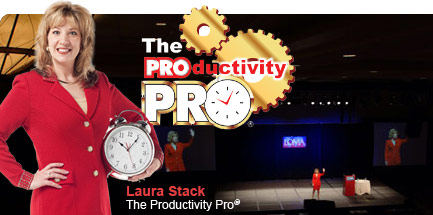How to Drive Workplace Productivity in a Virtual Office
In last month's newsletter, I discussed workplace delegation in light of the technological innovations that allow us to reach halfway across the world if desired to find ideal outsourcing providers. But in truth, you can apply this whiz-bang technology to employees in just about any category. Given access to reliable channels of instant communication, you no longer have to keep team members close at hand in order to maximize team and personal productivity.
The virtual office, administered and maintained via cyberspace, has truly come into its own. Your virtual assistant can live in Michigan and your receptionist in Florida, while your prestigious professional address may place you in downtown Manhattan, even if you run everything from your home in the Hamptons. When managed properly, this scenario can work well, since it cuts business costs to the bone, while maintaining the necessary professionalism.
But with every worker just a phone call or email away, a virtual office doesn't work the same way as the old-fashioned kind; in fact, it can exaggerate certain issues managers have always faced, while providing new ones to deal with. So how do you drive workplace productivity in the virtual office of this brave new world?
The Right People, Right from the Start
As with any work group, you first face the challenge of finding the right people to fill the slots in your virtual office team. Arguably, your greatest difficulty will possibly be an inability to meet your new employees in person before you hire them. Telephone and web-cam interviews can make up the shortfall, but they don't offer the sense of intimacy you get from occupying the same room with someone. If nothing else, you miss a lot of their body language.
On the other hand, since they probably won't work directly with you or most of your other team members, their personalities may not matter much to you. In the end, the value of any employee boils down to the kind of results that person can deliver. Can they provide high-quality work on time? Carefully check their references and feedback to tease out this information before you take them on, and if you can't immediately find it, dig deeper until you do.
Many of us hire virtual contract workers through online employment platforms like elance.com and guru.com and odesk.com. As a buyer, you hold most of the cards, since the providers pitch to you; you can then consider them at your leisure. But exercise caution during the selection process. Don't yield to the temptation of selecting the cheapest provider, or the one who presents the slickest pitch, unless they really do offer the best deal. Otherwise, you may end up disappointed—and you could end up spending more money. As the old saying goes: measure twice, cut once.
Finally, take care to match up your employee’s skill sets as you hire them, with each individual complementing the others and filling in the gaps in their technical expertise. You can't always engineer a perfect fit; but if you work to get it as close as possible, you'll have an easier time coordinating the group later. Try for some overlap, too, so you can have backups for those times when someone calls in sick or has to deal with a personal emergency.
Scheduling
A virtual office need not follow a traditional schedule—and probably can't, especially if your employees live in different time zones, much less on different continents. Don't assume everyone can make themselves available at any particular time. 2 PM in Chicago works out to 1 AM in Mumbai. Even in the U.S.A., time zones can present problems, as three hours separate the eastern and western seaboards.
With a virtual workforce, you're better served by (mostly) allowing people to keep their own schedules. For most things, it doesn't matter if someone gets your email at 3 AM your time. You should, however, ask each employee to set a specific range of hours when they intend to be available if you urgently need to contact them. Make sure they include their time zone, or ask for it in Greenwich Mean Time (GMT).
You may occasionally want to conduct a conference call with your scattered employees, in which case some of them might need to call in significantly earlier or later than their norm. If so, try to switch off the times when you schedule the calls, so you don't unfairly burden anyone by repeatedly making them work during their off hours. Show that you’re willing to take the hit yourself, if necessary. You may not want to conduct a meeting at 5 AM or 9 PM, but you might have to do so occasionally.
Depending on the size of your virtual office, consider using scheduling software to keep track of everyone. This may not prove necessary if your team consists of only four or five workers you can keep straight in your head, but any number greater than that may push the envelope, especially during busy periods. You'll find a plethora of online scheduling apps that work in a variety of ways, but at the very least consider setting up a schedule on Microsoft Outlook or Google calendar that blocks out the availability hours for each person on your team. Doodle.com is a great resource for finding a block of time that works for everyone.
As the manager of a virtual office, you'll want to embrace flexibility in your scheduling...and in everything else, really. Maybe you can afford rigidity if everyone lives within a few miles of the office and congregates there at set hours, but that mindset just doesn't work when some of your employees live thousands of miles away.
Trust and Results
The military has a saying: "A great leader starts with the big picture, and then works his way down to the details." The same goes for office managers, virtual or not. Your team, whether a "platoon" or "company" in size, needs you to focus on the organization's overarching goals, not on the details of accomplishing them.
Therefore, step back and consider the whole canvas, while trusting your people to work on the individual brushstrokes (within certain broad guidelines, of course). This empowers them to do the job as they see fit, providing results independent of some hidebound procedure. Remember: in the final analysis, only results matter.
So tell your employees when you need something done, set priorities (negotiating as necessary), and turn them loose. Take into account their stated needs, time-wise and otherwise. As long as the results meet your needs, how an employee accomplishes a task doesn't matter in the greater scheme of things.
Some managers are challenged by such a hands-off approach. With a virtual office, you can't just get up, walk down the hall, and see how far someone has gotten on a specific task. Instead, you have to call them or shoot them an email. Even then, you can't even guarantee they'll answer as fast as you'd like; it all depends on their email or phone discipline, and what their schedules look like.
Under these circumstances, micromanaging becomes even more useless than in a traditional office setting. You literally can't stand over someone's shoulder and direct their work...and why would you want to? If you've done a good job of putting your team together and communicating your requirements—and both are crucial, perhaps more so than in a traditional office—then you won't have to waste your time over-managing. You can't afford to anyway.
Either trust your people to do their jobs well and on time, or replace them. Give them the benefit of the doubt, and work around the inevitable blips; people really do get sick, and they really do have family crises. But if they prove you can't trust them to do the work, then cut the cord and find someone who can deliver the results you require.
Communications
Good communication has always been essential to the bottom line, but nowhere does it come into sharper focus than in the virtual office. As manager, you act as the hub that holds the wheel of your team's progress together; and fortunately, in this techno-happy age, you have plenty of channels to help you do so, from telephones to email to IMs.
When you relay instructions, make them as precise as possible, and request confirmation (especially if the worker speaks something other than English as their first language). Again, establish priorities as necessary, so the worker knows what you need done in what order, and especially what you need done first. Set specific deadlines, and make sure they fully comprehend those deadlines...and the consequences of not meeting them. Patiently allow them to ask as many questions as necessary in order to get things down pat.
In addition, ask for fairly frequent updates, though not so frequent they get in the way of getting the work done. I've already emphasized the importance of trust in a healthy work relationship, yet we've all heard the saying, "Trust, but verify." Once you've worked with the person for a while, and they've proven they can do the work the way you need it done, then you can cut back on the updating requirements.
Always keep the lines of communication open in both directions. Make yourself available to your employees by multiple means, if they feel they need to contact you. You needn't allow them to IM you or phone you personally, but they must be able to contact you by email at least, if only to turn in their work. (Though, of course, in some instances they can use collaborative software instead). If you have an assistant, you could route direct contact through them, so you can get your high-level work done.
Wrapping It Up
The virtual office offers businesses opportunities scarcely dreamt of a few decades ago. Before, human resources were basically limited to the population accessible within a reasonable drive (whether by wagon or car, depending on the century). Now that our global communications web is up and running, we literally have the world to choose from.
Once you've gotten things up and running, the whole affair can become too freewheeling and loose. This may require slightly tighter management than in the traditional workplace. Even so, exercise as much flexibility as you can, and don't waste time micromanaging your virtual workers.
Get the right people in place. Employ flexibility in your office scheduling. Trust your workers to do their jobs however they want, as long as they deliver results—but verify. Deliver your directives as precisely as possible, requiring confirmation every time. Most importantly, make sure the lines of communication stay open and clear in all directions.
Ultimately, it all comes down to good, old-fashioned communication. Once you've got that in place, you'll find it much easier to get team-wide alignment on your projects and goals, and to ensure the team accomplishes everything efficiently and with a minimum of fuss.
If you'd like further details on how to construct and maintain an effective workflow process that allows you to get everything done and still have a life outside of work, be sure to grab a copy of my new book, What To Do When There's Too Much To Do, when it hits bookstores in 2012.
Make it a productive day! (TM)
© Copyright 2012 Laura Stack. All rights reserved. www.TheProductivityPro.com | 


